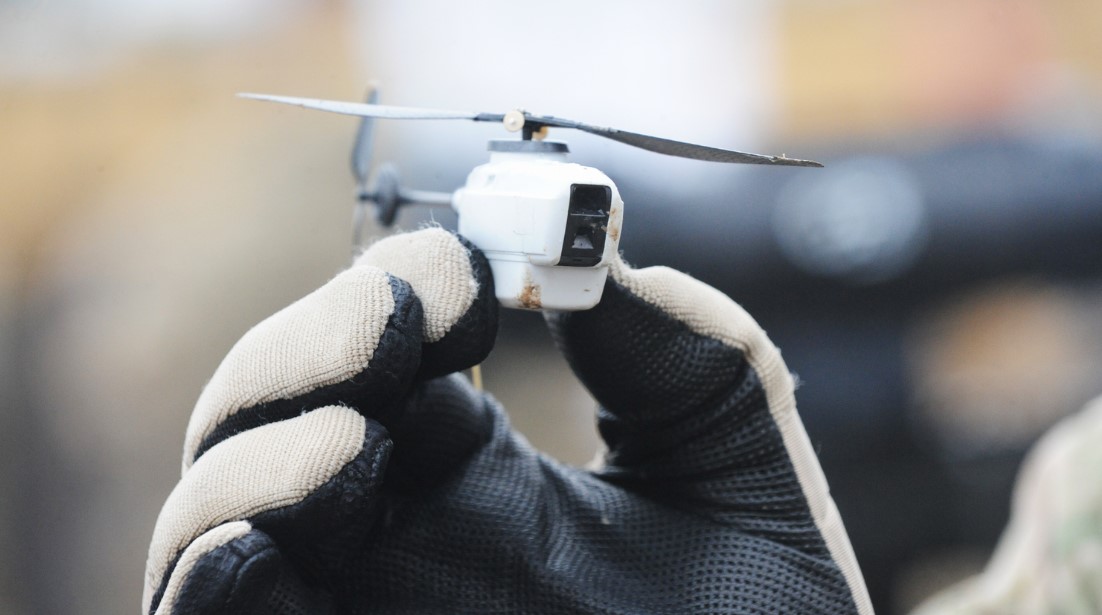Longtime readers might remember when we first began discussing and warning about insect-sized drones and drone swarms more than a decade ago. The insect-drone concept is thought to have originated as far back as at least the 1970s with the CIA pursuing a dragonfly drone. Since then, we have seen an increasingly rapid development in drone technology, as well as a military push to further automate their capabilities.
We now have robobees that no longer need a power source, as well as microdrones that can use power lines to harvest energy, as seen in the video below.
In the world of drone mad science we’ve also seen an effort recently to create zombie drones made from dead birds as another method of hiding in plain sight. Larger drone systems already have achieved mass coordination from a single human drone operator where more than one hundred quadcopters can be synchronized with the help of virtual and augmented reality.
Apparently, current systems are still too clumsy for military planners. As Defense One reports below, the latest advancement removes hand-held controls altogether and turns over control of a bug-sized drone (or drone swarm) to voice commands. While this is alarming enough, no mention is made of the potential infusion of ChatGPT or other generative AI systems which not only can clone voice commands, but potentially could offer a whole new level of automation that drifts beyond human control.
US Military Now Has Voice-Controlled Bug Drones
Tomorrow’s missions may take U.S. special operators into places where they’d rather not control drones by hand, so the maker of the popular Black Hornet nano-drone has added a way to steer it by simple voice commands.
U.S. operators began using the Black Hornet after seeing British forces flying them in Afghanistan in 2011. Years of experiments with optical and thermal cameras have turned the nano-drone into a key element of the U.S. Army’s soldier-borne sensor program. Now its manufacturer, Teledyne FLIR, has teamed up with AI startup Primordial Labs to add voice control.
At the Global SOF Foundation’s SOF Week event here, a drone operator used a book-sized computer and a few quick voice commands to send a drone to a series of locations in a noisy conference hall.
The software could be used for just about any kind of drone or system, said Mick Adkins, who runs product and business development for Primordial Labs. He said U.S. Special Operations Command had asked for a demo on seven types of drones, using “a whole inventory of discrete commands,” including “manipulating the sensor, looking at things, moving elevation, interacting with waypoints.”
The mission-level commands, the mission-type orders that we’re supporting right now are things like route, area, and zone reconnaissance, searching between a point, orbiting a point, conducting different scan patterns within a given area. And we’re actually on contract with [U.S. Army Special Operations Command] to add 100 autonomous behaviors this year,” he said.
Because ordering a flying bug drone around is potentially more complicated than steering it with a joystick, the Primordial Labs team worked to make sure the software could understand the user’s intention across a variety of different ways to order the drone to do something. That’s key as multiple operators may need to issue commands to the drone depending on the situation.
Primordial Labs CEO Lee Ritholtz previously worked with DARPA and Lockheed Martin on software for autonomous F-16s. He said that the company next hopes to enable the drone to talk back to its operator about what it sees—that is, what it detects using object-recognition software. So the software might tell the operator how many people, trucks, or enemy troops are in a particular area. Depending on the drone and the optics package, it might pick up things like a hidden firearm that the naked eye might miss. Ritholtz said that he hoped to debut that capability next year but cautioned, “It’s a very hard problem and I would not take anyone seriously who says it’s easily solved.”
Nicholas West writes for Activist Post and Counter Markets.
Become a Patron!
Or support us at SubscribeStar
Donate cryptocurrency HERE
Subscribe to Activist Post for truth, peace, and freedom news. Follow us on SoMee, Telegram, HIVE, Flote, Minds, MeWe, Twitter, Gab, What Really Happened and GETTR.
Provide, Protect and Profit from what’s coming! Get a free issue of Counter Markets today.


Be the first to comment on "The Black Hornet Nano-drone Can Now Be Controlled by Voice Commands"